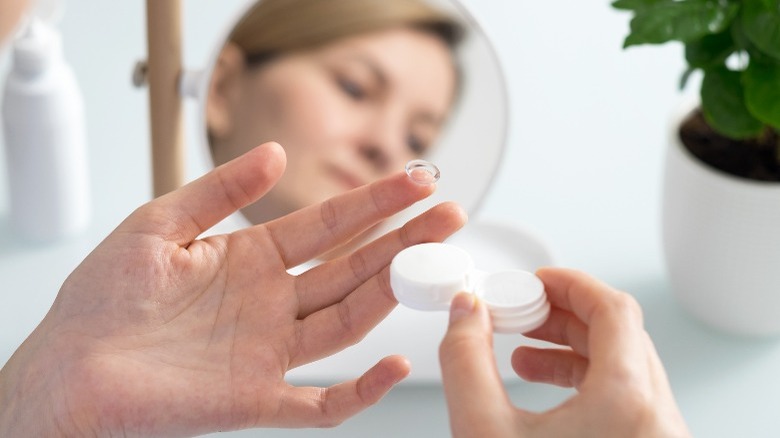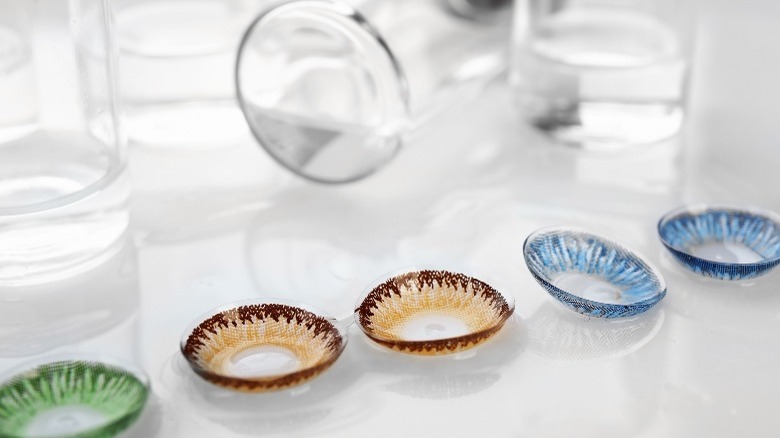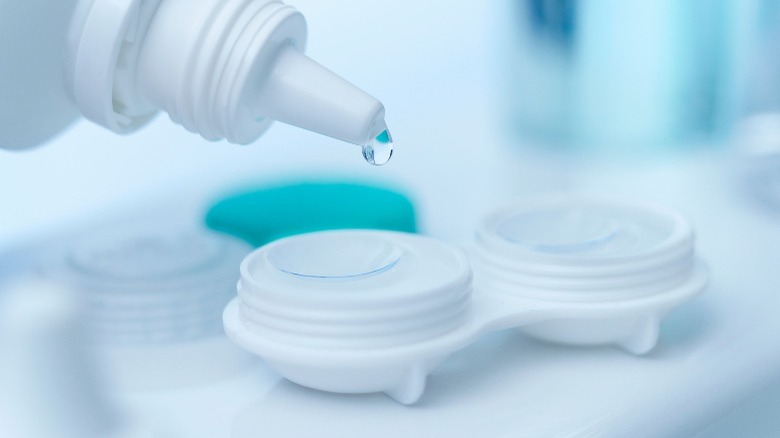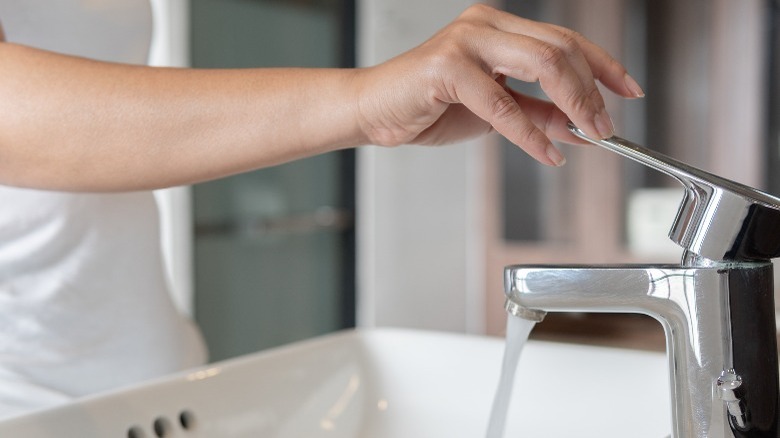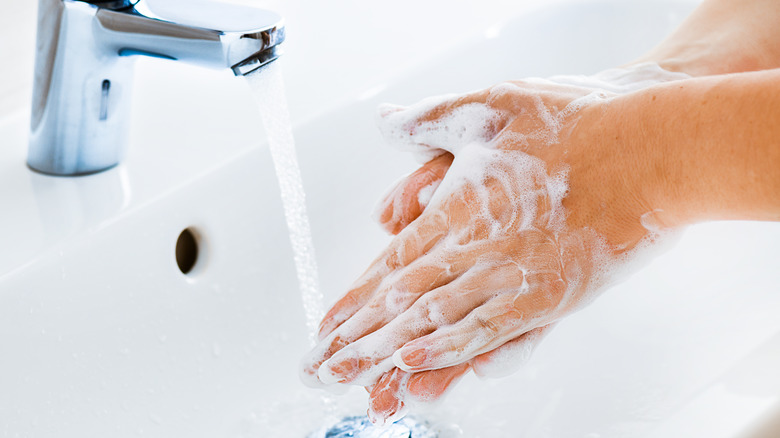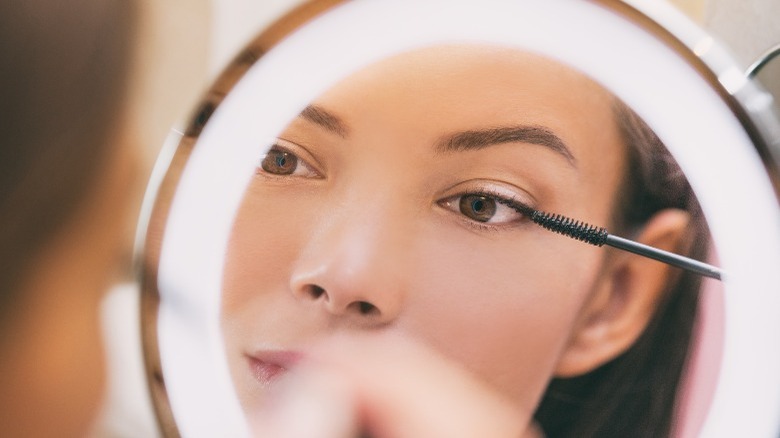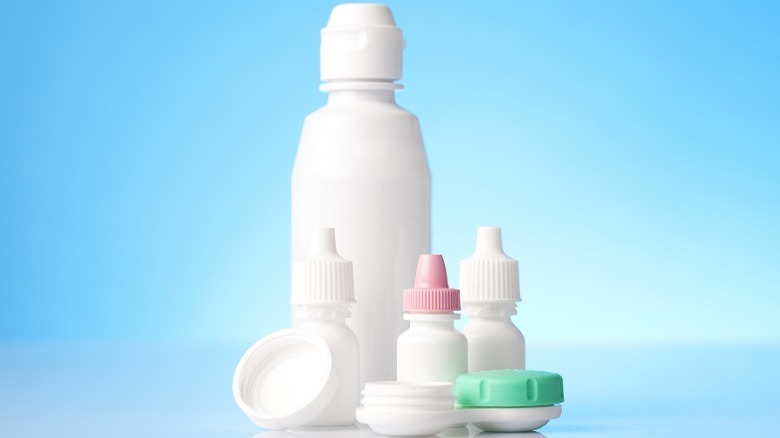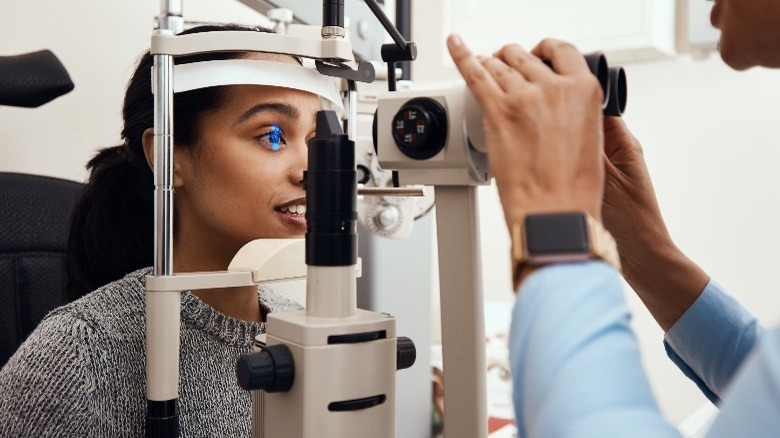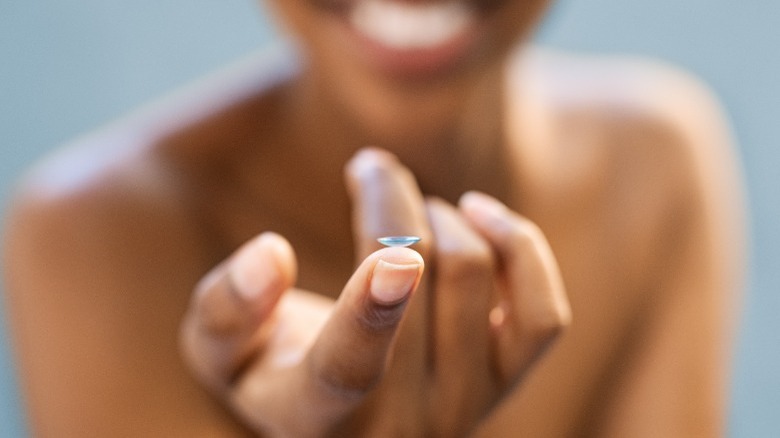Important Things You Should Know If You Wear Contact Lenses
For those who struggle with imperfect vision, contact lenses are often an essential part of everyday life. As described by the American Academy of Ophthalmology, contact lenses are clear plastic disks that are worn in the eye to improve a person's sight. Unlike eyeglasses, these thin lenses sit on top of the tear film in the eye, which covers and protects the eye's cornea. Ideally, contact lenses go unnoticed while helping a person to see clearly.
Contact lenses can correct different types of vision issues, including nearsightedness and farsightedness (via the National Eye Institute). Depending on the type and severity of vision loss you have, there are several kinds of contact lenses that could work best for you. Soft contact lenses are the most common type, providing the flexibility and comfort that many contact wearers prefer. Hard contact lenses are stiffer than their soft counterparts, which may be difficult to get used to for some people. However, their rigidity can actually slow the progression of nearsightedness, correct astigmatism, and offer clearer vision (per Healthline).
Although contact lenses can make life a lot easier for people with poor vision, they do require some care and maintenance to get the most out of them. Your eye health can suffer if you don't follow the best practices for cleaning, storing, and replacing your contacts (via Cleveland Clinic). Here's what you need to know about contact lenses.
You shouldn't swim with contact lenses
While it might seem harmless to jump into a swimming pool or wade in the beach waves while wearing your contacts, you could be putting your eye health at risk. Swimming with your contacts in your eyes is unsafe because the lenses can soak up some of the water that gets in your eyes, potentially absorbing bacteria, viruses, chemicals, and harmful microbes (via Healthline). Prolonged exposure to these pathogens to your eyes can lead to an eye infection, inflammation, irritation, dryness, and other dangerous eye issues.
But what if removing your contacts isn't an option? Many individuals with strong prescriptions cannot see without their contacts or glasses — and glasses are less than ideal for swimming or water activities. Eyeglasses quickly become spotted with water and can easily come off or float away.
If you must wear your contacts while swimming, the Optometrists Network suggests wearing goggles to protect your lenses, removing them immediately after swimming, thoroughly disinfecting your contacts after exposure to water, and using rewetting drops to prevent dry eyes. Although these tips don't guarantee you won't experience any issues, they can reduce the risk of developing an eye infection.
Show your contact lens case some love
You might place a lot of emphasis on caring for your contacts by thoroughly cleaning and disinfecting them before and after every wear. However, the often neglected contact case should be an essential part of your eye care routine, too. If you don't take care of your contact lens case, harmful bacteria can grow inside and transfer to your eyes (via Visionworks).
The American Optometric Association (AOA) recommends cleaning your contact case after each use, keeping it open and allowing it to dry when not in use, and switching out your contact case every three months. Following these steps ensures that your contact lenses are placed in a clean, fresh container for disinfecting and storage after every use, which will help to keep your eyes healthy.
Visionworks also shares steps on how to properly clean your contact lens case. First, empty the case of any used contact solution, which may contain dangerous bacteria and irritants. Next, wash your hands to remove germs you may have on your skin which can transfer to your contact case. Then, add some clean contact solution to your case and rub the storage compartments and caps with your finger to loosen and remove any buildup. Dump it out and rinse the case with more solution until all deposits are gone. Finally, place your case face down, allow it to air-dry completely, and reseal it when dry.
Even colored or decorative contact lenses need a prescription
It can be tempting to buy decorative contact lenses for a costume or dramatic effect, but you could end up with costly — and painful — consequences if you don't have a prescription. The U.S. Food & Drug Administration (FDA) warns about purchasing over-the-counter contacts to prevent eye injuries that can occur when wearing lenses that don't properly fit your eyes.
For example, when these cosmetic lenses are not the right size or measurement for your eyes, you risk scratches to the corneas, corneal infections, pink eye, decreased vision, and even blindness. Also, decorative contact lenses typically don't come with instructions on how to clean or insert them, which can also lead to eye problems.
The FDA also notes that selling decorative contact lenses without a prescription is against the law. The lenses do not fall within the category of cosmetics or other products that can be sold over the counter. Any contact lenses, even those that do not correct vision, require a prescription and can only be sold by authorized distributors.
According to an American Optometric Association article, AOA president Robert C. Layman, O.D. shares, "It's extremely important that patients get an eye exam and only wear contact lenses, with or without vision correction, that are prescribed for and fitted to your eyes by a doctor of optometry." If you must indulge in colored lenses, be sure to see an eye doctor and get a prescription.
You can't actually lose your contact lens behind your eye
Although it can be alarming to realize your contact lens has somehow drifted to the back of your eye, it can't actually get stuck there. However, contacts can become dislodged from their position in the front of the eye after rubbing or accidentally bumping or touching the eye. The lenses commonly move to the top of the eye under the eyelid, leaving you wondering where it went and frantic to get it out.
The good news is that it's impossible for your contact lens to get trapped behind your eye (via All About Vision). The moist lining under the eyelids, called the conjunctiva, actually folds over at the top of the eyelid to double back and cover the outer layer of the eyeball. In an interview with Self, AOA president-elect Andrea Thau, O.D. explains, "[The conjunctiva] membrane goes across the white of the eye and up and under the eyelid, creating a pouch all the way around." This natural barricade prevents anything from getting into the back part of the eyeball, including slippery contact lenses.
With that said, you don't have to panic if you suddenly lose your contact in your eye. You can get it out by applying a few contact rewetting drops and gently massaging the top on your eyelid until the lens drops down and you can remove it (per All About Vision).
Reusing contact solution is a no-no
Running low on contact solution and don't have time to run to the store? Don't even think about reusing the disinfecting solution that's in your case. After your contacts soak in the solution, it may contain infection-causing bacteria and harmful irritants that will only make your lenses dirtier if you try to use the solution again (via Visionworks).
The FDA also warns against "topping off" the solution already in your case. Even if you add some fresh solution to the used liquid, the solution is not sterile and will not disinfect your contacts properly. If you don't have enough solution to safely clean and store your lenses, it's better to throw them out and use a fresh pair the next time you decide to wear contacts.
The AOA adds that it's important to follow the care instructions given by the contact lens solution's manufacturer. If the recommendations say to only store your contacts in the solution for a limited duration, you should switch it out according to that schedule, even if you don't plan on wearing your contacts. In general, the limit to store your contact in the same solution is 30 days. After that, you'll need to toss those lenses for a new set.
Never use tap water to store your lenses
Another common assumption that many contact wearers make is that water is a safe alternative for storing contact lenses when solution is not available. However, using water, especially tap water, to clean or store contact lenses would be a mistake. Water may contain several contaminants, bacteria, and fungi that may be hazardous to your eye health (via All About Vision).
In particular, a microbe called acanthamoeba, which is commonly found in tap water, can easily stick to contact lens surfaces and infect the eyes when inserted (per the U.S. Environmental Protection Agency). An eye infection involving acanthamoeba from tap water can cause painful symptoms, including severe eye discomfort, the feeling of having something in the eye, and a whitish layer to the outer borders of the eye. While symptoms last for a few days to several months, the eye never fully heals — even with treatment.
Even if you have high-quality tap water in your area, it's better to be safe than sorry. Only use contact solution to store your lenses or opt for a fresh pair.
Following your wear schedule is actually a big deal
Many contact wearers are guilty of stretching out their wear schedules in the hopes of saving some money or avoiding another visit to the eye doctor. While these are innocent intentions, failing to follow the replacement schedule for your prescription can be uncomfortable and increase the risk of an eye infection and other eye health issues (via Optometrists Network).
As explained by Optometrists Network, wearing contacts for excessive amounts of time or wearing them longer than recommended restricts oxygen flow to your eye's cornea and blood vessels. The results include minor symptoms, such as dry eyes, irritation, lens discomfort, and bloodshot eyes, to more significant problems, like sores on the cornea, infection, corneal scarring, and vision loss.
A study published in Optometry and Vision Science found that overwearing daily contacts resulted in a buildup of proteins on the lenses, causing irritation, reduced sharpness in vision, an increase of small bumps on the eyelids called conjunctival papillae, and a risk of infection. To avoid these eye issues, always follow your contact lens wear schedule and replace them as often as recommended.
Scented hand soaps can affect your contact lenses
Your eye doctor will always recommend that you wash your hands before handling your contacts. However, the type of soap you use to clean your hands can actually make a difference when it comes to caring for your lenses and eye health. Many soaps may contain chemicals, essential oils, or moisturizers that can transfer to contact lenses and irritate eyes if not rinsed off completely (via National Keratoconus Foundation). The residue can also create a film on your contacts that will make your vision blurry.
The Optometrists Network suggests using an antibacterial soap that does not contain any scent to wash your hands before inserting or removing your contacts. However, the American Academy of Ophthalmology mentions that moisturizing soaps are safe to use, as long as you completely rinse the soap from your hands before touching your contact lenses. If your eyes are particularly sensitive, you can also find hand soaps on the market that are specifically designed for contact lens handling.
Makeup can damage your contact lenses
Applying makeup while wearing contacts can be tricky and may take some practice to avoid getting the products in your eye and on your contact lenses. Some cosmetics can actually leave a film or residue on the contacts and cause irritation if they get underneath the lenses. Eye makeup, including eye shadow, eyeliner, and mascara, and be particularly problematic for contact lens wearers because they can easily fall or flake off into the eyes (via CooperVision).
Johns Hopkins Medicine shares that wearing cosmetics with contact lenses may cause eye irritation, dryness, allergies, eye infections, and even injuries if you're not careful. The best ways to avoid these symptoms are to always insert your contact lenses before applying makeup, use trusted makeup brands that are hypoallergenic, avoid sharing cosmetics, and skip glittery eye shadows. L'Oréal Paris also suggests using eyeliner that glides on easily, waterproof mascara designed for sensitive eyes, and liquid eyeshadow to reduce powdery fallout.
The contact solution you use can make a difference
Not all contact lens solutions are created equal. These sterile liquids may use different ingredients to disinfect and clean lenses or provide added comfort for those who need it. For example, some types of contact solutions you can find on the market include multipurpose solutions, contact solutions for dry eyes, hydrogen peroxide-based solutions, and complete care systems for hard lenses (via Healthline).
People with sensitive eyes or specific types of contact lenses will find that certain contact solutions work better than others. If you need an affordable solution that disinfects and hydrates your lenses, a multipurpose solution may be your best option. For those with sensitive eyes or allergies, you can purchase a gentle saline solution to rinse your contacts before and after disinfecting them for optimal comfort (per Medical News Today).
Solutions that use hydrogen peroxide are another alternative if multipurpose solutions cause reactions or discomfort. However, you must use the special case provided with the solution, which changes the hydrogen peroxide to sterile saline over the course of a few hours (via the FDA). If you try to reinsert your lenses before the hydrogen peroxide is neutralized, you'll experience burning in your eyes and possible damage to the cornea.
Regular eye exams are important
After getting your contact lens prescription, you might feel like you're set for life. However, contact wearers should get annual exams to see if their eyes have changed and if contact lenses are still the best option for their type of vision loss. A thorough eye exam also helps detect eye diseases and other issues, which can lead to early treatment and improved vision (via the CDC).
According to VSP Vision Care, a contact lens exam is actually different from a routine eye exam. A regular eye check-up involves checking a person's eyesight and signs of potential problems. However, a contact lens exam involves different kinds of tests to see if your vision with contacts is as sharp as it should be. The doctor will also measure the surface of your eye in order to prescribe contact lenses that are the right size and fit. You'll also have a chance to discuss your contact lens options and which type is best for your needs.
Don't rewet contacts lenses with saliva
While it might be shocking that eyecare professionals even have to mention it, it's important to know that saliva is not a sterile or safe way to rewet your contacts. When your contacts are dry, irritating your eyes, or even fall out, don't stick them in your mouth to rewet them. The mouth is full of bacteria and other germs that can cause eye infections and other eye problems (via Yahoo! News). Your best bet is to throw away the problematic lenses and start with a new pair.
One type of eye infection that is common when using saliva to rewet lenses is keratitis, which involves inflammation of the cornea caused by bacteria, fungi, parasites, or viruses that find their way into the eye (per Mayo Clinic). Keratitis symptoms may include redness and pain in the eyes, excess of tears or eye discharge, blurred vision, and sensitivity to light. If you used your mouth to try to moisturize or clean your contact lenses and are experiencing these symptoms, it's time to schedule an appointment with your eye doctor.
Never share contact lenses
Even when you think you have the same prescription as a friend or family member, there are differences in eye measurements and shapes that make sharing contacts a bad idea. Not to mention, putting another person's contact lenses in your eyes potentially exposes you to all kinds of bacteria, viruses, and germs that can make you sick (per Bausch + Lomb).
In addition, wearing contacts that don't fit your eyes can increase the risk of corneal tears or ulcers and developing an eye infection (via WUSF Public Media). You may also develop contact lens intolerance (CLI) if you continue to wear poor-fitting contacts, which means you will no longer be able to wear contacts without pain or discomfort — even if the lenses you're trying to insert are your prescription (per Laser Eye Institute). Your eyes eventually reject wearing contact lenses and treat it as a foreign body in the eye.
When you're asked to share contact lenses, including decorative contacts, you should always avoid doing so to prevent damaging your eyes and potentially developing an intolerance for contact lenses in the future.
Sleeping in contact lenses is risky
Survey results shared by the CDC report that the most common risky behavior tied to contact lens care is sleeping in contacts. No matter how tired you might be, it's always better to remove your contact lenses before hitting the hay. Sleeping in contact lenses increases your chances of developing an eye infection and other problematic symptoms — even with extended-wear lenses. No matter what type of contacts you wear, the lenses reduce the flow of essential oxygen to the eye, which can affect your eye health and vision (per Sleep Foundation).
According to Cleveland Clinic, sleeping in contacts can cause dryness, redness, irritation, and damage caused by removing the lenses when they become stuck to the cornea. The Sleep Foundation adds that sleeping while wearing contacts can also lead to eye infections and permanent eye damage, including keratitis, inflammation of the cornea, and fungal infections.


